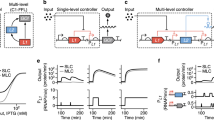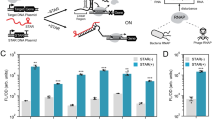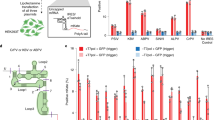Abstract
Many techniques have been developed for studying inducible gene expression, but all of them are multicomponent systems consisting of cis-acting elements at the DNA or RNA level, trans-acting regulator proteins and/or small molecules as inducers. RNA thermometers are the only known single-component regulators of gene expression. They consist of a temperature-sensitive secondary structure in the 5′ untranslated region of the mRNA, which contains the ribosome-binding site. The ribosome-binding site can be masked or unmasked by a simple temperature shift, thereby repressing or inducing translation. Recently, we and others have designed synthetic RNA thermometers that are considerably simpler than naturally occurring thermometers and can be exploited as convenient on/off switches of gene expression. In this protocol, we describe the construction and use of synthetic RNA thermometers. We provide guidelines for the in silico design of thermometer-controlled mRNA leaders and for their experimental testing and optimization; the entire procedure can be completed in 2–3 weeks.
This is a preview of subscription content, access via your institution
Access options
Subscribe to this journal
Receive 12 print issues and online access
$259.00 per year
only $21.58 per issue
Buy this article
- Purchase on Springer Link
- Instant access to full article PDF
Prices may be subject to local taxes which are calculated during checkout





Similar content being viewed by others
References
Mandal, M. & Breaker, R.R. Gene regulation by riboswitches. Nature Rev. 5, 451–463 (2004).
Winkler, W.C. & Breaker, R.R. Regulation of bacterial gene expression by riboswitches. Annu. Rev. Microbiol. 59, 487–517 (2005).
Serganov, A. & Patel, D.J. Ribozymes, riboswitches and beyond: regulation of gene expression without proteins. Nature Rev. Genet. 8, 776–790 (2007).
Henkin, T.M. Riboswitch RNAs: using RNA to sense cellular metabolism. Genes & Dev. 22, 3383–3390 (2008).
Winkler, W., Nahvi, A. & Breaker, R.R. Thiamine derivates bind messenger RNAs directly to regulate bacterial gene expression. Nature 419, 952–956 (2002).
Barrick, J.E. et al. New RNA motifs suggest an expanded scope for riboswitches in bacterial genetic control. Proc. Natl. Acd. Sci. USA 101, 6421–6426 (2004).
Mandal, M. et al. A glycine-dependent riboswitch that uses cooperative binding to control gene expression. Science 306, 275–279 (2004).
Serganov, A., Polonskaia, A., Phan, A.T., Breaker, R.R. & Patel, D.J. Structural basis for gene regulation by a thiamine pyrophosphate-sensing riboswitch. Nature 441, 1167–1171 (2006).
Storz, G. An RNA thermometer. Genes & Dev. 13, 633–636 (1999).
Narberhaus, F., Waldminghaus, T. & Chowdhury, S. RNA thermometers. FEMS Microbiol. Rev. 30, 3–16 (2006).
Morita, M.T. et al. Translational induction of heat shock transcription factor sigma32: evidence for a built-in RNA thermosensor. Genes Dev. 13, 655–665 (1999).
Nocker, A. et al. mRNA-based thermosensor controls expression of rhizobial heat shock genes. Nucleic Acids Res. 29, 4800–4807 (2001).
Chowdhury, S., Maris, C., Allain, F.H.-T. & Narberhaus, F. Molecular basis for temperature sensing by an RNA thermometer. EMBO J. 25, 2487–2497 (2006).
Chowdhury, S., Ragaz, C., Kreuger, E. & Narberhaus, F. Temperature-controlled structural alterations of an RNA thermometer. J. Biol. Chem. 278, 47915–47921 (2003).
Waldminghaus, T., Gaubig, L.C. & Narberhaus, F. Genome-wide bioinformatic prediction and experimental evaluation of potential RNA thermometers. Mol. Genet. Genomics 278, 555–564 (2007).
Johansson, J. et al. An RNA thermosensor controls expression of virulence genes in Listeria monocytogenes . Cell 110, 551–561 (2002).
Altuvia, S. & Oppenheim, A.B. Translational regulatory signals within the coding region of the bacteriophage lambda cIII gene. J. Bacteriol. 167, 415–419 (1986).
Neupert, J., Karcher, D. & Bock, R. Design of simple synthetic RNA thermometers for temperature-controlled gene expression in Escherichia coli . Nucleic Acids Res. 36, e124 (2008).
Waldminghaus, T., Kortmann, J., Gesing, S. & Narberhaus, F. Generation of synthetic RNA-based thermosensors. Biol. Chem. 389, 1319–1326 (2008).
Kozak, M. Initiation of translation in prokaryotes and eukaryotes. Gene 234, 187–208 (1999).
McCarthy, J.E.G. & Brimacombe, R. Prokaryotic translation initiation: the interactive pathway leading to initiation. Trends Genet. 10, 402–407 (1994).
Kozak, M. Regulation of translation via mRNA structure in prokaryotes and eukaryotes. Gene 361, 13–37 (2005).
Li, Y. & Altman, S. A specific endoribonuclease, RNase P, affects gene expression of polycistronic operon mRNAs. Proc. Natl. Acad. Sci. USA 100, 13213–13218 (2003).
Chen, H., Bjerknes, M., Kumar, R. & Jay, E. Determination of the optimal aligned spacing between the Shine–Dalgarno sequence and the translation initiation codon of Escherichia coli mRNAs. Nucleic Acids Res. 22, 4953–4957 (1994).
Chalfie, M., Tu, Y., Euskirchen, G., Ward, W.W. & Prasher, D.C. Green fluorescent protein as a marker for gene expression. Science 263, 802–805 (1994).
Zhou, F. et al. High-level expression of HIV antigens from the tobacco and tomato plastid genomes. Plant Biotechnol. J. 6, 897–913 (2008).
Oey, M., Lohse, M., Kreikemeyer, B. & Bock, R. Exhaustion of the chloroplast protein synthesis capacity by massive expression of a highly stable protein antibiotic. Plant J. 57, 436–445 (2009).
Zuker, M. Mfold web server for nucleic acid folding and hybridization prediction. Nucleic Acids Res. 31, 3406–3415 (2003).
Hanahan, D. Studies on transformation of Escherichia coli with plasmids. J. Mol. Biol. 166, 557–580 (1983).
Birnboim, H.C. & Doly, J. A rapid alkaline extraction procedure for screening recombinant plasmid DNA. Nucleic Acids Res. 7, 1513–1523 (1979).
Laemmli, U.K. Cleavage of structural proteins during the assembly of the head of bacteriophage T4. Nature 227, 680–685 (1970).
Schägger, H. & von Jagow, G. Tricine-sodium dodecyl sulfate-polyacrylamide gel electrophoresis for the separation of proteins in the range from 1 to 100 kDa. Anal. Biochem. 166, 368–379 (1987).
Acknowledgements
We thank D. Karcher (Max Planck Institute of Molecular Plant Physiology) for helpful discussion and comments on the paper.
Author information
Authors and Affiliations
Contributions
J.N. and R.B. jointly prepared the paper.
Corresponding author
Rights and permissions
About this article
Cite this article
Neupert, J., Bock, R. Designing and using synthetic RNA thermometers for temperature-controlled gene expression in bacteria. Nat Protoc 4, 1262–1273 (2009). https://doi.org/10.1038/nprot.2009.112
Published:
Issue Date:
DOI: https://doi.org/10.1038/nprot.2009.112
This article is cited by
-
Natural antisense RNAs as mRNA regulatory elements in bacteria: a review on function and applications
Cellular & Molecular Biology Letters (2016)
-
Bacterial RNA thermometers: molecular zippers and switches
Nature Reviews Microbiology (2012)
Comments
By submitting a comment you agree to abide by our Terms and Community Guidelines. If you find something abusive or that does not comply with our terms or guidelines please flag it as inappropriate.



